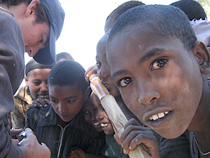
Dr. Lietman is investigating what community treatment strategies are most effective in eliminating trachoma. He and Dr. Porco are constructing mathematical models to determine who within communities needs to be targeted, how often communities need to be treated, and whether the World Health Organization’s antibiotic treatment program is in danger of generating significant drug resistance. He and Dr. Keenan are conducting clinical trials that evaluate the long term effect of mass antibiotic treatment of trachoma to determine if infectious trachoma can, indeed, be eliminated with repeat community antibiotic treatment. Drs Lietman, Acharya, Keenan, and Rose-Nussbaumer are running corneal ulcer trials in collaboration with the Aravind Eye Care System in South India and corneal ulcer prevention trials in collaboration with Seva, Bharatpur Eye Hosptial, and Aravind. |
Mathematical Modeling of Infectious Diseases
T. Lietman and T. Porco
The World Health Organization (WHO) recommends mass administration of single-dose oral antibiotics in trachoma endemic areas. However it is not clear how often mass treatment should be administered. Clinical trial results, including those being performed by the Proctor Foundation, are providing useful information, but will take years to complete and may be prohibitively expensive. Mathematical models can help assess whether infectious trachoma can be eliminated, not just controlled, as is the current WHO goal. Our studies suggest infection can be eliminated if mass antibiotic treatments are given repeatedly (annually in areas of moderate disease, and perhaps even biannually in hyperendemic areas). Further operations research is being done to determine if these estimates are indeed accurate, and tailoring treatment frequencies to countries of different endemicity. We have also shown with mathematical models that if infection is eliminated from a core group of children, then it should disappear from the rest of the community as well. We are now developing strategies from these models to bring about elimination using the fewest possible antibiotic treatments.
A single dose of azithromycin is extremely effective in eliminating the causative agent of trachoma, Chlamydia trachomatis, from an individual. In addition to chlamydia, azithromycinhas antibacterial activity against many bacterial species including pathogenic bacteria that are routinely found in trachoma endemic communities. While chlamydia has remained sensitive to macrolides and azalides including azithromycin, other bacteria may develop resistance, and there is some concern that large-scale trachoma programs may interfere with bacterial flora. Drs. Porco and Lietman are using mathematical models of chlamydia and streptococcus transmission to estimate the amount of drug resistance caused by trachoma programs.
Trachoma Community Treatment Strategies
N. Stoller, Z. Zhou, J. Keenan, J. Whitcher, S. Yu, B. Gaynor, T. Porco, and T. Lietman
It is uncertain if annual repeat treatment of trachoma with mass azithromycin distribution will eliminate ocular Chlamydia from a community, particularly in hyperendemic areas. We have recently completed the NIH-funded TANA-TIRET study, in collaboration with the Carter Center and the Ethiopian Ministry of Health. We were able to demonstrate that children form a core group for trachoma—that is, if you eliminate infection in children, then it should disappear in the rest of the community. We have also found that biannual treatments are more likely to completely eliminate infection that annual treatments. Future studies will determine if infection will return after treatments are discontinued.
We are soon completing a research program funded by the Gates Foundation through Johns Hopkins University (PI Dr. Sheila West) that determines whether complete elimination in the entire community is possible by only treating a core group of children. This study is taking place in Matamaye District, Niger, in collaboration with the Programme National de Lutte Contre la Cécité.
Mortality Reduction with Oral Azithromycin Administration
N. Stoller, S. Yu, Z. Zhou, J. Keenan, J. Whitcher, B. Gaynor, T. Porco, and T. Lietman
In our Ethiopian trachoma studies, we also monitor mortality with antibiotic administrations, as diarrhea, respiratory infection, and malaria are all major causes of infant mortality and all may be affected by azithromycin. We found that in pre-school children, mortality was reduced with the mass antibiotic treatments, even though the target disease trachoma is not itself a lethal disease. We are in the process of setting up a large, 3-country (Niger, Tanzania, and Malawi), community-randomized clinical trial to confirm this reduction in mortality, funded by the Bill and Melinda Gates Foundation. This trial will need to be far larger than the previous study--it will be performed in an area totaling 1,500,000 individuals.
Fungal Ulcer treatment: the Mycotic Ulcer Treatment Trials
T. Lietman, N. Acharya, K. O’Brien, K. Ray, J. Whitcher, M. Zegans, S. McLeod, P. Lalitha, and N. Prajna
With Dr. Nisha Acharya at UCSF, and our Indian colleagues at the Aravind Eye Hospital, we are evaluating which topical agent, voriconazole or natamycin, is the superior treatment for fungal keratitis in a randomized, masked, controlled trial. Historically, fungal ulcers are relatively uncommon in the United States. They make up only about 8% of infectious ulcers seen at the Proctor Foundation at UCSF prior to 2005. However, in the past year, there has been an epidemic of keratitis due to Fusarium species in the U.S., and caring for these patients has become a particular concern for corneal specialists. In warmer, tropical climates, fungal ulcers have always been endemic. In settings such as South India, as many as one half of infectious ulcers are fungal. We recently completed a pilot study, and are in now the midst of a second, 240-patient trial. The Aravind Eye Hospital in Tamil Nadu is the ideal partner for this project.
Corneal ulcer prevention: the Village Integrated-Eye Worker study
T. Lietman, J. Keenan, K. O’Brien, J. Whitcher, M. Srinivasan, N. Acharya, and M. Srinivasan
When infectious corneal ulcers present to health care facilities, the infection can typically be eliminated, although there is often little that can be done to prevent corneal scarring and subsequent blindness. With the corneal ulcer team at Proctor and our colleagues at SEVA and the Aravind Eye Hospital, we are evaluating whether corneal ulcers can be prevented. RPB and the NIH-NEI have funded a community-randomized trial in which ½ the communities are randomized to have a village eye care worker treat all corneal abrasions within 24 hours. The other ½ of communities will receive diabetes screening. We will monitor incident corneal ulcers over 24 months.

